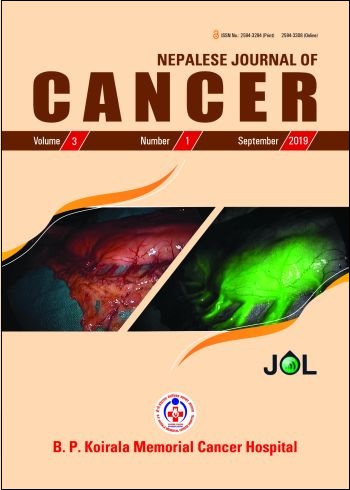Carcinoma of Vulva in Nepalese Women Managed at B. P. Koirala Memorial Cancer Hospital
DOI:
https://doi.org/10.3126/njc.v3i1.25913Keywords:
Carcinoma of vulva, chemotherapy, groin node dissection, radiation therapyAbstract
Introduction: This study aims to analyze the clinical presentation and management outcomes carcinoma of vulva managed B. P. Koirala Memorial Cancer Hospital.
Methods: A descriptive study was conducted of all carcinoma of vulva cases managed at B. P. Koirala Memorial Cancer Hospital from 1999 to 2009. The case record of all women diagnosed to have carcinoma of vulva were retrieved and socio-demographic characteristics, clinical presentations, histological type, treatment modalities and outcome were obtained and analyzed.
Results: There were 5152 gynecological malignancies and vulvar cancer accounted for 87, giving a prevalence of 1.7%. The ages ranged from 17 to 86 years (mean of 48.6 years). Parity was 0-10. Vulva wound and pruritus were the most frequent clinical features with presentations in stage I -8%, stage II- 28%, stage III – 52 % and stage IV -12%. Squamous cell carcinoma (93%) predominated and 62% were grade I. Among the 87 cases, 32% were treated primarily with surgery, 34% primarily with concurrent chemo-radiation and 28% with combined modality. Clinical follow-up of one to five years showed that 26 (30%) cases had local recurrence and 22 (25%) died of disease.
Conclusion: Carcinoma of the vulva is a rare gynecological malignancy in Nepal. Surgery and radiotherapy remain to be the mainstay of treatment. Delayed presentation still results in greater morbidity and mortality rates.
Downloads
Downloads
Published
How to Cite
Issue
Section
License
This license lets others distribute, remix, tweak, and build upon your work, even commercially, as long as NJC and the authors are acknowledged.
Submission of the manuscript means that the authors agree to assign exclusive copyright to NJC. The aim of NJC is to increase the visibility and ease of use of open access scientific and scholarly articles thereby promoting their increased usage and impact.




